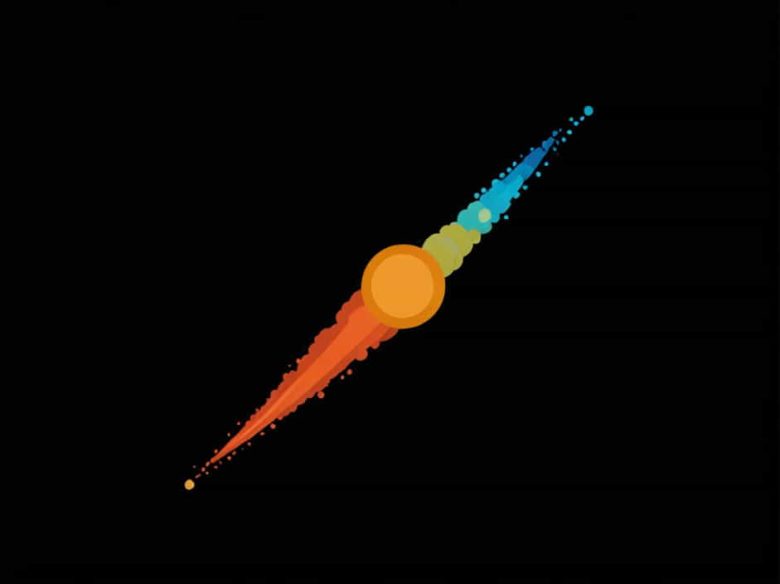The Hertzsprung-Russell (HR) diagram is one of the most important tools in astronomy for understanding stars. It is a graph that plots stars based on their luminosity (brightness) and temperature (color). This diagram helps astronomers study stellar evolution, classify different types of stars, and predict how stars change over time.
In this topic, we will explore what an HR diagram is, how it is used, and why it is essential in modern astrophysics.
What Is the Hertzsprung-Russell Diagram?
The HR diagram was developed independently by Ejnar Hertzsprung and Henry Norris Russell in the early 20th century. It shows how stars of different sizes, temperatures, and brightness are related.
Axes of the HR Diagram
The HR diagram has two main axes:
- X-axis (Temperature or Spectral Type)
- Runs backwards, meaning hotter stars (blue) are on the left, and cooler stars (red) are on the right.
- Often labeled with spectral types: O, B, A, F, G, K, M (from hottest to coolest).
- Y-axis (Luminosity or Absolute Magnitude)
- Measures how bright a star is compared to the Sun.
- The Sun has a luminosity of 1.
- Bright stars are near the top, and dim stars are near the bottom.
The Importance of the HR Diagram
The HR diagram allows astronomers to see patterns and relationships between stars. By plotting stars, they can determine:
- Where a star is in its life cycle
- How stars evolve over time
- The classification of different star types
Main Regions of the HR Diagram
Stars on the HR diagram are grouped into several key regions based on their properties.
1. Main Sequence Stars
The main sequence is a diagonal band running from the top left (hot, bright stars) to the bottom right (cool, dim stars).
- About 90% of all stars fall into this category, including the Sun.
- These stars generate energy through hydrogen fusion in their cores.
- Examples: Sirius, Alpha Centauri A, and Proxima Centauri.
2. Red Giants and Supergiants
Located in the upper right of the HR diagram, these stars are:
- Cooler but very bright due to their enormous size.
- In the late stages of their life cycle, having used up most of their hydrogen fuel.
- Examples: Betelgeuse, Aldebaran, and Antares.
3. White Dwarfs
Found in the lower left of the HR diagram, these stars are:
- Very hot but dim because they are small and no longer undergoing fusion.
- The remnants of dead stars that have shed their outer layers.
- Examples: Sirius B and Procyon B.
How Stars Move on the HR Diagram
Stars do not stay in one place on the HR diagram forever. As they evolve, they move to different regions:
- Newborn stars start in the main sequence.
- As they run out of hydrogen, they become red giants.
- Eventually, they shed their outer layers, leaving behind a white dwarf.
This movement helps astronomers predict the future of stars based on their current position.
Spectral Classification and the HR Diagram
The HR diagram is closely related to spectral classification, which divides stars based on their temperature and color.
Spectral Types of Stars
Stars are classified into seven main spectral types:
| Spectral Type | Temperature (Kelvin) | Color | Example Star |
|---|---|---|---|
| O | > 30,000 K | Blue | Zeta Puppis |
| B | 10,000-30,000 K | Blue-White | Rigel |
| A | 7,500-10,000 K | White | Sirius |
| F | 6,000-7,500 K | Yellow-White | Procyon A |
| G | 5,200-6,000 K | Yellow | Sun |
| K | 3,700-5,200 K | Orange | Arcturus |
| M | < 3,700 K | Red | Betelgeuse |
This classification helps astronomers understand a star’s position on the HR diagram.
How the HR Diagram Helps in Understanding Stellar Evolution
The HR diagram is a powerful tool for studying how stars change over billions of years.
1. Birth of Stars (Protostars)
- Stars begin as clouds of gas and dust that collapse under gravity.
- They do not appear on the HR diagram until they start nuclear fusion.
2. Main Sequence Phase
- Stars spend most of their life in the main sequence.
- Hydrogen fusion in the core produces energy and balances gravity.
3. Red Giant Phase
- When hydrogen runs out, the core contracts while the outer layers expand.
- The star moves to the upper right of the HR diagram.
4. White Dwarf Stage
- After shedding outer layers, the leftover core becomes a hot, dense white dwarf.
- The star moves to the lower left of the HR diagram.
Why the HR Diagram Is Important for Astronomy
The HR diagram is one of the most useful tools in astrophysics because it helps astronomers:
- Classify stars based on temperature and brightness.
- Determine the age and evolution of star clusters.
- Measure distances to stars using standard candles like Cepheid variables.
- Predict how stars will change over time.
Modern Uses of the HR Diagram
With advanced telescopes and space missions, scientists continue to use the HR diagram in new ways:
1. Space Telescopes and Star Surveys
- The Hubble Space Telescope has plotted HR diagrams for distant galaxies.
- The Gaia mission has mapped over a billion stars, improving HR diagrams.
2. Studying Exoplanet Host Stars
- By placing exoplanet host stars on the HR diagram, scientists can determine if a star system is stable for life.
3. Understanding the Universe’s History
- By comparing HR diagrams of different star clusters, astronomers can estimate the age of galaxies and the Milky Way.
The Hertzsprung-Russell (HR) diagram is one of the most fundamental tools in astronomy. It helps classify stars, understand stellar evolution, and measure cosmic distances. By plotting stars based on luminosity and temperature, astronomers can predict how they change over time.
As telescopes and observational techniques improve, the HR diagram will continue to play a crucial role in unraveling the mysteries of the universe.



